

Sewn_circuits.pdf. LED Robot Quiet Book Page. Quiet books, welcome to the 21st century!
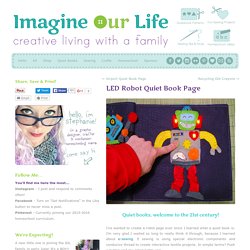
I’ve wanted to create a robot page ever since I learned what a quiet book is. Introducing the LilyPad Design Kit! Congratulations on your LilyPad Design Kit!
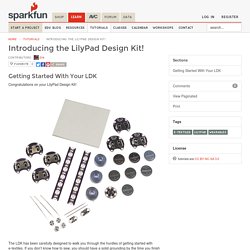
The LDK has been carefully designed to walk you through the hurdles of getting started with e-textiles. If you don’t know how to sew, you should have a solid grounding by the time you finish these 6 experiments. If you don’t know anything about electronics, we’ll have you building microcontroller circuits in no time! Don’t know either? BUCKLE UP and let’s do this thing!
The kit is divided into six experiments, so you’ll learn in six easy steps, with lots of links to explain sewing and electronics terminology and basic concepts. Insulation Techniques for e-Textiles. Favorited Favorite 1 Introduction This tutorial introduces five different methods for insulating conductive thread traces in an e-textile project.
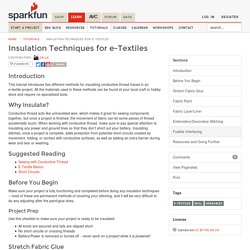
All the materials used in these methods can be found at your local craft or hobby store and require no specialized tools. Why Insulate? Conductive thread acts like uninsulated wire, which makes it great for sewing components together, but once a project is finished, the movement of fabric can let some pieces of thread accidentally touch. Suggested Reading. HOW TO GET WHAT YOU WANT. Welcome to the KOBAKANT DIY Wearable Technology Documentation Workshops least likely scenario This workshop is part of a course at the Ernst Busch Hochschule in Berlin.
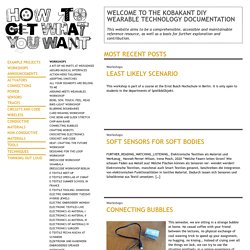
It is only open to students in the departments of Spiel&&Objekt. Workshops. Your solution provider for smart fabrics and interactive textiles. ElectroPUFF Craft Kit. Discover the magic of electronics textiles!
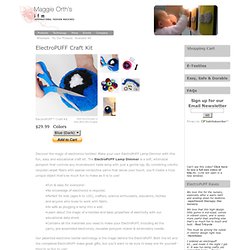
Make your own ElectroPUFF Lamp Dimmer with this fun, easy and educational craft kit. Joy Slippers Version 2. These slippers have 4 analog pressure sensors embedded.
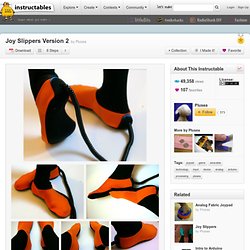
They can be used to feed Up, Down, Left and Right values into your computer replacing your mouse, joystick... Visit the JoySlippers website >> This Instructable improves upon the previous version It will show you how to make a pair of Joy Slippers, connect them to an Arduino physical computing platform and run a Processing application that will allow you to draw with your feet, as seen in the following video.
Conductive Fabric. Soft Circuit Saturdays Tutorials. LED and Fiber Optic Lighting by Wiedamark - Fiber Optic End Glow. Learn.adafruit. Easy EL Wire Projects. "Easy EL Wire Projects" gives you the complete step-by-step instructions for 10 different projects to light up your wardrobe.
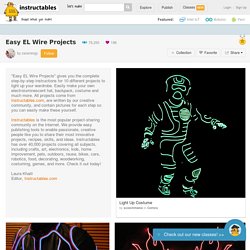
Easily make your own electroluminescent hat, backpack, costume and much more. All projects come from Instructables.com, are written by our creative community, and contain pictures for each step so you can easily make these yourself. Instructables is the most popular project-sharing community on the Internet. We provide easy publishing tools to enable passionate, creative people like you to share their most innovative projects, recipes, skills, and ideas. How-To videos for eTextiles, soft circuits and wearable computing. How to sew an electronic circuit. Lightwings: Fiber Optic Fairy Wings. LED and Fiber Optic Lighting by Wiedamark - Fiber Optic Cable.
Beginning Soft Circuits. Knit a Working Circuit Board. For this instructable, I'll demonstrate how to knit circuitry, using a simple LED circuit as an example.
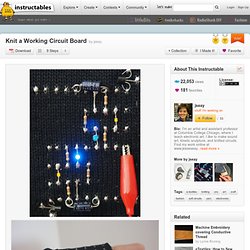
The instructions assume you already know how to knit, solder, and wire up LEDs. Make Your Own E-Textile Arduino Board. The ATtiny85 chip is a simple $2 way to get into Arduino.
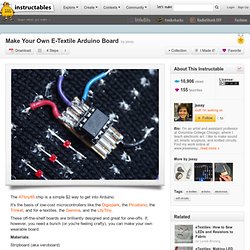
It's the basis of low-cost microcontrollers like the Digispark, the Picoduino, the Trinket, and for e-textiles, the Gemma, and the LilyTiny. These off-the-shelf boards are brilliantly designed and great for one-offs. If, however, you need a bunch (or you're feeling crafty), you can make your own wearable board. Materials: LED Earrings. Bluetooth Glove: Version 3.0. 10 Fabulous and Fashionable Wearable Projects from Becky Stern. LED Shoe Clips.
Step #3: PrevNext Gently singe the edges to prevent fraying.

Step #5: Fold remaining circles into wedges and compile in a stack with the illuminated wedges evenly distributed in the ruffle stack. Step #6: Be sure both longer positive leads are facing the same side of the stack, and stitch the fabric in place with plain thread. Step #8: Start the soft battery holder with a piece of felt shaped to double over the coincell battery. Step #9: Using two pieces of conductive thread, sew a pad at the center of each felt circle with leads hidden in the felt sprouting from one outer side. Step #11: Stitch the ruffle assembly to the top of the battery holder with standard thread. Step #12: PROJECTS. An exploration into the possibilities for individual construction and customization of the most ubiquitous of electronic devices, the cellphone. … more Electronic Popables Electronic Popables is an interactive pop-up book that sparkles, sings, and moves.
The book integrates traditional pop-up mechanisms with thin, flexible, paper-based electronics and the result is a book that … more Codeable Objects Codeable Objects is a library for Processing that enables novice coders, designers and artists to rapidly design, customize and construct an artifact using geometric computation and digital fabrication The programming … more Self-folding Origami Paper A first-step toward origami robotics, I/O paper is a pair of origami papers in which the red (controller) paper senses how it is being folded and the white (output) paper … more. DIY PROJECTS THAT COMBINE FABRIC, ELECTRONICS AND PROGRAMMING. The 10 Most Amazing Electronic Clothes Of the Century.
Computers? Clothes? What's the difference? Let’s face it, without the technology you use everyday you’d be pretty stuck. No automatic coffee pot, no iPhone, no GPS helping you crash your car. Knit a Working Circuit. Forget about circuit boards and start thinking about circuit stitches with this illuminating tutorial by electronic art professor Jesse Seay on how to knit your own circuitry. …I developed a method to “print” circuit boards on my knitting machine, with materials that are inexpensive, easily available, and solderable. The method works with both traditional electronic components and with e-textile components. And while I use a knitting machine for rapid production, the materials should work fine for hand knitters.
As Seay explains in the introduction, this tutorial assumes that you already know how to knit and shows you how to integrate wiring into your knitting by design a knitting pattern that will allow you to make connections between electronic components, just like an ordinary circuit board. How Wearable Technology Works"
For most people, fun is the hook that makes new technology worth investigating. Wearable technology promises entertainment galore. Video games are bigger than ever, with cinematic appeal and wow-inducing special effects. Still, the games would be more immersive with more life-like control systems. That's what the PrioVR plans to deliver. Depending on the model, you'll attach between eight and 17 inertial sensors to your body. Arduino LilyPad for Clothing. Overview The LilyPad Arduino is a microcontroller board designed for wearables and e-textiles.
It can be sewn to fabric and similarly mounted power supplies, sensors and actuators with conductive thread. The board is based on the ATmega168V (the low-power version of the ATmega168) (datasheet) or the ATmega328V (datasheet). Clothing Gets Computerized. Soft Circuit Saturdays Tutorials. Basic Electronics - Videos. Soft Circuits.